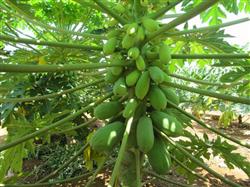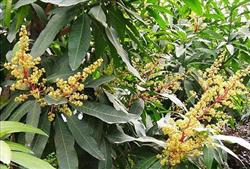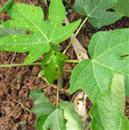Cultivation and management techniques of papaya

1. Select excellent varieties. Suitable for local varieties are Yizhou papaya, poinsettia papaya and so on, and can pollinate each other. 2. Planting and establishing the garden. It is appropriate to choose loam or sandy loam with deep and fertile soil layer, good drainage, neutral or slightly alkaline soil. The row spacing is 2.5 m × 4 m. Before planting, dig a planting hole with a length of 1 meter, a width of 1 meter and a depth of 0.8 meters, and apply 10 kg mature organic fertilizer to each hole. Before planting, the improved varieties and strong seedlings of 2-3 years old can be planted in spring or autumn, and before the seedlings sprout in spring, and before the fallen leaves of the trees are planted in autumn, the roots of the trees are easy to heal, the survival rate is high, and the growth is good. The grafted seedlings are more than 1.2 meters high, the grafting site is more than 1 cm thick, and the interface healing is good. It is required that the root system is intact, the planting depth should be level with the ground after planting and watering, and 1 square meter of plastic film should be covered on the tree plate. 3. Fertilizer and water management. Base fertilizer was applied when turning over the orchard in late September, mainly stable fertilizer, human feces and urine, mixed with available N fertilizer, 15-30 kg per young tree and 30-50 kg per big tree. Topdressing: before sprouting (from late March to early April), 130 grams of urea and 400 grams of ternary compound fertilizer were applied in each plant. The mixture of 0.3% urea, 1% calcium superphosphate and 0.3% potassium sulfate was sprayed once 2 weeks before anthesis to promote fruit cell division; 0.2% boric acid or 0.3% borax was sprayed at full flowering stage, which was beneficial to fruit setting. In the middle and last ten days of May, 100-250 grams of urea were applied to each fruiting tree, which could be applied in ring or furrow. After the fruit was harvested, the compound fertilizer dominated by nitrogen fertilizer was applied, 0.5 kg per plant. Water management. Generally, water should be irrigated once before and after flower bud germination, during fruit expansion and shoot growth period, and anti-freezing water should be irrigated with base fertilizer before winter. at the same time, papaya should be drained in time for fear of waterlogging. 4. Shaping and pruning. The stem height of the natural round head is 70-80 cm, and 3-4 new shoots are left as the main branches. the main branches should be arranged in 3-4 different directions, each main branch should have a distance of 10-20 cm, and there are 2-3 lateral branches on the main branch. the lateral side of the lateral branch reproduces branchlets or bear fruit mother branches and branches. Summer pruning: mainly take measures such as wiping buds, coring, pulling branches and so on. Erase buds: remove the buds below the plastic band in time, as well as the upright buds on the back of the main branch and the competitive branches on the extended branches. Heart-picking: when the main branch grows to 50-60 cm, the heart is removed to promote the secondary branch, and the main branch is cultivated. The growth of other parts is strong, the upright overlaps with the main branches, and the new shoots that cross grow to 20 cm to promote secondary shoots. Pull branches: generally at the end of August and the beginning of September, the branches that are not reserved as main branches are flattened and reserved as auxiliary branches. Winter pruning: for the purpose of shaping and expanding the crown, the young papaya trees should cut short the branches left as the main branches in the first year, leaving 30-40 cm, and the young trees are mainly light pruning, mainly to remove dense branches, competitive branches, cross branches and overlapping branches. cut short the branches with space, leaving 20-30 cm, and pick the heart in time to form a fruiting branch group when it grows to 40 cm in the next year. 5. Flower and fruit management. In order to obtain high and stable yield, suitable pollination trees are needed when the garden is built. The ratio of main varieties to pollinated varieties is 4:1. Poor management of papaya will lead to years, so attention should be paid to flower and fruit management. In the big year, flower and fruit thinning is particularly important. When fruit thinning, we should first remove the branch head fruit, deformed fruit, cross fruit, generally choose the basic fruit and middle fruit of the branch, fruit spacing of about 20 cm, in order to ensure large fruit, high yield and stable yield. 6. Disease and pest control. There are few diseases of papaya, mainly insect pests, such as aphids, papaya borer, red spiders and so on. ⑴ can spray 5000-6000 times of imidacloprid to aphids and other pests in May, once in 15 days, 2-3 times in a row. ⑵ used peach Xiaoling or peach small one-time net 1500-2000 times to control papaya borer in mid-June and late July. ⑶ can control red spider with 2000 times scavenging rate.
- Prev

The method of soil testing and formula fertilization for mango
Mango flowering and fruit setting period is a very important period in mango production and management. the management measures of mango flowering and fruit setting period are as follows: 1. Arrangement of flowering branches and shoots. Remove overdense branches, shade weak branches and disease and insect branches about 2 months before flower bud differentiation, leaving only 1 or 2 shoots per branch, which can increase the crown.
- Next

Control of root rot of papaya seedlings
Papaya is a subtropical crop, which is raised and transplanted. The analysis shows that the main causes of root rot at seedling stage are stagnant water in seedling bed after rain, high concentration of fertilization at seedling stage, invasion of nematodes and root rot pathogens. Prevention and control measures: 1. The root system of papaya should carry out respiration in the soil. Hypoxia under the condition of hypoxia.
Related
- Moge, come on! The staff of the peasant association in the producing area of cantaloupe were frightened when the crowd gathered.
- Causes and Solutions of low Fruit setting rate of Apple
- Symptoms and control measures of passion fruit virus disease
- Fruit growing lesson: how do apple orchards keep high yields?
- Can you build orchards in the mountains? What are the pros and cons?
- How to manage the coloring period of Crisson grape?
- This paper introduces the processing technology of two kinds of fig products.
- How much is a month for retired teachers in rural areas by 2020?
- How can strawberry planting increase sugar content? We should pay attention to management in many aspects.
- What are the cultivation techniques on how to improve the yield of golden fruit?

